Happy Feast of St. Ignatius! Today’s the feast day of my confirmation saint, St. Ignatius of Loyola, the founder of the Jesuits.
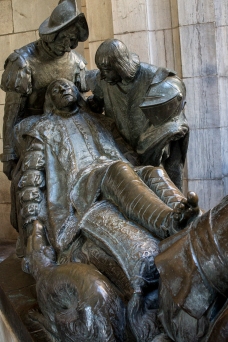
A statue depicting the wounding of St. Ignatius of Loyola outside his home
A little backstory on him. So he was born Iñigo Lopez de Loyola in 1491 in Loyola, a small village Azpeita in northern Spain. He gained acclaim as a soldier and was climbing in status until 1521, when a cannonball took out his legs while defending Pamplona against the French. One leg was broken, but the other was severely mangled. Multiple surgeries (without anesthetics) were performed to save his life and maybe legs, but with how he was deteriorating, no one was optimistic about his survival, much less recovery. But on the feasts of St. Peter and Paul, Ignatius began to improve, but the mangled leg was still deformed and the broken leg was shorter than the other. He had the deformity removed and tied a cannonball to the other leg and let it hang to attempt to stretch the other leg out for hours on end. Again, analgesia wasn’t really a thing back then, so none of this felt great…but he was determined. While spending months convalescing, he was bored and wanted something to read. He was hoping for stories of knights, valor, battle, but instead got the lives of Christ and the saints. The room of his convalescence then became the room of his conversion, with those stores filling him with the fire to serve God and His people. During his prayer, he would be filled with a sense of peace, reaffirming his decision. He even laid down his military garments in front of an image of the Black Madonna at the Benedictine Monastery Santa Maria de Montserrat and began practicing spiritual exercises in a cave in Manresa.
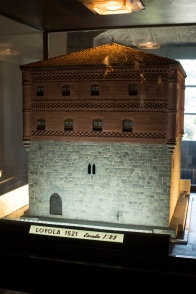
A replica of the original home in Loyola
Now that was all well and good, but considering Mass and all educated communication was done in Latin (which he knew nothing of), he had to start somewhere. And that somewhere was a 30-year-old Ignatius in a Latin class with a bunch of 10-year-olds. He advanced in his education in Alcala and Salamanca until earning his master’s degree at the College of Saint Barbe of the University of Paris at age 44. While there, he roomed with Peter Faber and Francis Xavier, who began to follow Ignatius and his spiritual exercises. The group traveled to Rome to present themselves as a religious order to the Pope and serve him since their dreams of traveling to the Holy Land were impeded by a conflict between the Turks and Venetians. Pope Paul III approved them as an official religious order in 1540 and Ignatius was elected the first leader of the Society of Jesus. Those who opposed them called them “Jesuits,” but with all the good work they were doing, the name was no longer seen as derogatory.
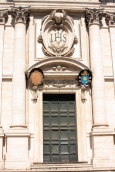
The Church of the Gesu in Rome
The Society of Jesus is known for educating the youth because of their advocacy of using reason and logic to persuade others and fight heresy. The Jesuits were responsible for a large percentage of the work in stopping the spread of the Protestant Reformation. At the time of his death on July 31, 1556, the order had 35 schools…that number has grown significantly since then.
He was beatified by Pope Paul V in 1609 and canonized in 1622. His patronage includes the Society of Jesus, soldiers, educators and education.
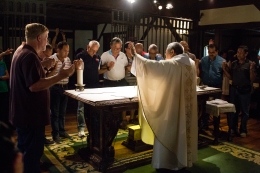
A Father’s Day blessing by Fr. Roger during our pilgrimage especially fitting since my father was the one that introduced me to St. Ignatius of Loyola
My dad was the one that introduced me to St. Ignatius back as a high school freshman when I had to pick a saint for Confirmation. As an awkward teenager whose friends were going with the more popular saints, I was not as eager with my father’s choice for me (and resented that fact that he didn’t let me pick my own since “adulthood in the Catholic Church” is kind of the shtick of Confirmation). My dad guided me that direction because academic success was extremely important to me. But little did I know how much St. Ignatius would return to me time and time again in multiple forms.
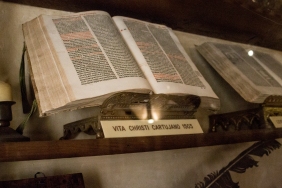
The Life of Christ on display in St. Ignatius’ home in Loyola
The first time I made a real personal connection was back in college. On top of returning to my home parish to help out with high school retreats, I was heavily involved in Longhorn Awakening and STRONG. The former is a large biannual retreat hosted at the University Catholic Center and the latter is a team that hosts retreats for youth groups in the Diocese of Austin that otherwise would not have the opportunity. It was getting to the point where I was averaging a retreat a month. I was even pushed by my friends into a leadership role in Awakening because I was so involved that I could almost literally run it in my sleep. A few years into college, I learned who the patron saint of retreats was…St. Ignatius, the founder of the Spiritual Exercises himself.

Under this tree was where I did the majority of my meditations during the silent retreats
Speaking of retreats, I had one of my most powerful spiritual experiences during an adaptation of the Spiritual Exercises at a Jesuit retreat site in Lake Dallas. A few college friends had gone on a silent retreat over Memorial Day weekend that was based on the Spiritual Exercises of St. Ignatius. Divided over four years, each retreat would be one week of the month-long exercises, and with each return, you would progress through. During these, I found the courage to begin to accept my homosexuality and began to let go of my subliminal self-loathing. During my meditations there, I truly experienced the concept of spiritual consolation, that sense of peace that St. Ignatius himself experienced during his conversion.

The bedazzled statue of St. Ignatius that’s revealed daily at 5:00pm in the Church of the Gesu
During our pilgrimage to Italy last year, we visited many sites across the country, including Assisi where St. Francis (my brother’s Confirmation saint) rests. We had planned to extend our trip for a few days in Rome after the completion of the pilgrimage, so we scheduled a side trip to Nettuno to visit St. Maria Goretti’s tomb since she was Marissa’s patron saint. But as far as I knew, St. Ignatius was Spanish, so I didn’t figure I was going to get much on my end in this regard. However, I forgot that the Jesuits were founded in Rome. While on the tour bus, our guide pointed out the Church of the Gesu, stating that St. Ignatius laid there. We added that to our personal itinerary, and we went to visit around 5:00pm at our guide’s suggestion. In comparison to the St. Francis and St. Maria Goretti, St. Ignatius’ tomb was much more ornate and elaborate. And at 5:00pm, a presentation began that ended with the painting dropping from behind his tomb to reveal a bedazzled statue of St. Ignatius while all of the lights lit up the church like it was Easter. My brother and Marissa both looked at me like, “of course your saint would be the bougie one.” The apartment that St. Ignatius lived and died in was next door to the church, so we got to go through that as well.
Then this year, during our Marian pilgrimage, we happened to be driving through
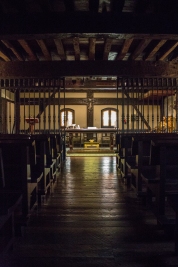
The Chapel of Conversion
northern Spain to get to Lourdes. My mother had told the priest in an unrelated conversation about how my patron saint is St. Ignatius, and apparently his eyes lit up at the opportunity for another pit stop and added Loyola to the itinerary. The basilica was impressive, but the tour of the home of St. Ignatius was the most powerful experience I had on the trip. We got to enter the rooms where he lived and prayed, the room where he was born, and most significantly the room where he convalesced and converted. The room, now turned into the Chapel of Conversion, was where we held our daily mass on that day of the trip. But I was filled with awe and emotion to know that I was walking the very same floors within the very same walls looking at the very same beams that were present when the fire was lit in St. Ignatius to change from military to clergy.
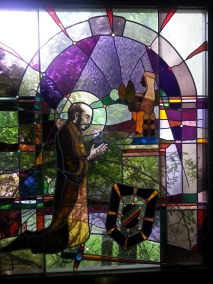
The stained glass window at the Montserrat retreat center in Lake Dallas depicting St. Ignatius laying down his sword and shield in front of the Black Madonna
It’s funny that I was considering doing the newer Camino Ignaciano next year leading up to my 30th birthday just because the travel bug had bit hard and that I’ve also been more heavily considering grad school in Nursing Informatics to both advance my education and give myself a change of pace from the craziness of the ER. Until doing some quick research to review the life of St. Ignatius while writing this post, I hadn’t realized that his conversion happened at the age of 30 as well. While the changes I’m looking to make in my own life are much different than his, the parallel is amusing to me. It looks like my dad had me pegged much more accurately than any of us could have known.
